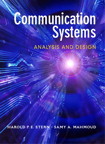PSpice for Digital Communications Engineering
暫譯: 數位通信工程中的 PSpice
Tobin
- 出版商: Morgan & Claypool
- 出版日期: 2007-04-12
- 售價: $1,930
- 貴賓價: 9.5 折 $1,834
- 語言: 英文
- 頁數: 216
- ISBN: 1598294326
- ISBN-13: 9781598294323
-
相關分類:
通訊系統 Communication-systems
海外代購書籍(需單獨結帳)
買這商品的人也買了...
-
 Visual C++ 6 教學手冊 (Beginning Visual C++ 6)
Visual C++ 6 教學手冊 (Beginning Visual C++ 6)$580$458 -
 JSP 與 Servlet 500 個應用範例技巧大全集
JSP 與 Servlet 500 個應用範例技巧大全集$590$460 -
 Java 2 JDK 5.0 教學手冊, 3/e
Java 2 JDK 5.0 教學手冊, 3/e$590$460 -
 系統分析與設計使用UML實現物件導向方法, 2/e (Systems Analysis and Design with UML Version 2.0 : An Object-Oriented Approach, 2/e)
系統分析與設計使用UML實現物件導向方法, 2/e (Systems Analysis and Design with UML Version 2.0 : An Object-Oriented Approach, 2/e)$650$585 -
 深入淺出 Java 程式設計, 2/e (Head First Java, 2/e)
深入淺出 Java 程式設計, 2/e (Head First Java, 2/e)$880$695 -
 Java 網路程式設計 (Java Network Programming, 3/e)
Java 網路程式設計 (Java Network Programming, 3/e)$880$695 -
 作業系統原理 (Silberschatz: Operating System Principles, 7/e)
作業系統原理 (Silberschatz: Operating System Principles, 7/e)$780$741 -
 ASP.NET 2.0 深度剖析範例集
ASP.NET 2.0 深度剖析範例集$650$507 -
 SQL 語法範例辭典
SQL 語法範例辭典$550$435 -
 Linux 驅動程式, 3/e (Linux Device Drivers, 3/e)
Linux 驅動程式, 3/e (Linux Device Drivers, 3/e)$980$774 -
 Flex 2 程式設計 (Programming Flex 2: The comprehensive guide to creating rich media applications with Adobe Flex)
Flex 2 程式設計 (Programming Flex 2: The comprehensive guide to creating rich media applications with Adobe Flex)$780$616 -
 精通 MFC 視窗程式設計─Visual Studio 2005 版
精通 MFC 視窗程式設計─Visual Studio 2005 版$750$593 -
 超圖解 Excel VBA 基礎講座
超圖解 Excel VBA 基礎講座$420$332 -
 聖殿祭司的 ASP.NET 2.0 專家技術手冊─使用 C#, 2/e
聖殿祭司的 ASP.NET 2.0 專家技術手冊─使用 C#, 2/e$720$569 -
 C 語言初學指引, 2/e
C 語言初學指引, 2/e$480$408 -
 超圖解 Excel VBA 應用講座
超圖解 Excel VBA 應用講座$420$332 -
 Linux 核心詳解, 3/e (Understanding the Linux Kernel, 3/e)
Linux 核心詳解, 3/e (Understanding the Linux Kernel, 3/e)$1,200$948 -
 Visual C++ 網路通訊程式實用案例精選
Visual C++ 網路通訊程式實用案例精選$580$458 -
 深入淺出物件導向分析與設計 (Head First Object-Oriented Analysis and Design)
深入淺出物件導向分析與設計 (Head First Object-Oriented Analysis and Design)$880$695 -
 ActionScript 3.0 錦囊妙計 (ActionScript 3.0 Cookbook)
ActionScript 3.0 錦囊妙計 (ActionScript 3.0 Cookbook)$880$695 -
 現代嵌入式系統開發專案實務-菜鳥成長日誌與專案經理的私房菜
現代嵌入式系統開發專案實務-菜鳥成長日誌與專案經理的私房菜$600$480 -
 Embedded Linux 開發實務徹底研究 (Embedded Linux Primer: A Practical Real-World Approach)
Embedded Linux 開發實務徹底研究 (Embedded Linux Primer: A Practical Real-World Approach)$720$569 -
 ASP.NET 問題解決實戰
ASP.NET 問題解決實戰$580$458 -
 XNA PC / Xbox 360 C# 遊戲程式設計
XNA PC / Xbox 360 C# 遊戲程式設計$450$356 -
 CCNA 認證教戰手冊 (CCNA: Cisco Certified Network Associate Study Guide (Exam 640-802), 6/e)
CCNA 認證教戰手冊 (CCNA: Cisco Certified Network Associate Study Guide (Exam 640-802), 6/e)$1,180$932
商品描述
Description
PSpice for Digital Communications Engineering shows how to simulate digital communication systems and modulation methods using the very powerful Cadence Orcad PSpice version 10.5 suite of software programs. Fourier series and Fourier transform are applied to signals to set the ground work for the modulation techniques introduced in later chapters. Various baseband signals, including duo-binary baseband signaling, are generated and the spectra are examined to detail the unsuitability of these signals for accessing the public switched network. Pulse code modulation and time-division multiplexing circuits are examined and simulated where sampling and quantization noise topics are discussed. We construct a single-channel PCM system from transmission to receiver i.e. end-to-end, and import real speech signals to examine the problems associated with aliasing, sample and hold.
Companding is addressed here and we look at the A and mu law characteristics for achieving better signal to quantization noise ratios. Several types of delta modulators are examined and also the concept of time divisionmultiplexing is considered. Multi-level signaling techniques such as QPSK andQAMare analyzed and simulated and ‘home-made meters’, such as scatter and eye meters, are used to assess the performance of these modulation systems in the presence of noise. The raised-cosine family of filters for shaping data before transmission is examined in depth where bandwidth efficiency and channel capacity is discussed. We plot several graphs in Probe to compare the efficiency of these systems. Direct spread spectrum is the last topic to be examined and simulated to show the advantages of spreading the signal over a wide bandwidth and giving good signal security at the same time.
商品描述(中文翻譯)
**描述**
《PSpice for Digital Communications Engineering》展示了如何使用功能強大的 Cadence Orcad PSpice 10.5 版本軟體套件來模擬數位通信系統和調變方法。傅立葉級數和傅立葉變換應用於信號,以為後面章節介紹的調變技術奠定基礎。生成各種基帶信號,包括雙二進制基帶信號,並檢查其頻譜,以詳細說明這些信號不適合接入公共交換網路。脈衝編碼調變(Pulse Code Modulation, PCM)和時分多工電路進行了檢查和模擬,並討論了取樣和量化噪聲的主題。我們從傳輸到接收器,即端到端構建一個單通道 PCM 系統,並導入實際語音信號以檢查與混疊、取樣和保持相關的問題。
這裡討論了壓縮編碼(Companding),並查看 A 法則和 μ 法則的特性,以實現更好的信號與量化噪聲比。我們檢查了幾種類型的增量調變器(Delta Modulators),並考慮了時分多工的概念。分析和模擬了多級信號技術,如 QPSK 和 QAM,並使用“自製計量器”,如散射計和眼圖計,來評估這些調變系統在噪聲存在下的性能。深入檢查了提升餘弦濾波器(Raised-Cosine Filters)在傳輸前塑造數據的應用,並討論了帶寬效率和通道容量。我們在 Probe 中繪製了幾個圖表,以比較這些系統的效率。直接擴頻(Direct Spread Spectrum)是最後一個主題,進行檢查和模擬,以顯示在寬帶寬上擴展信號的優勢,同時提供良好的信號安全性。













